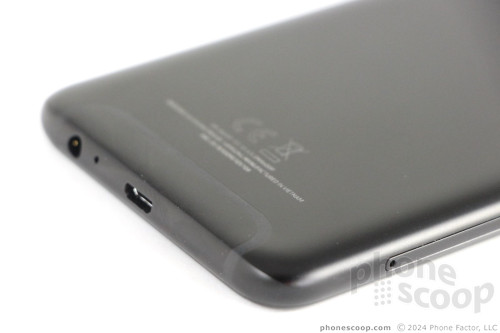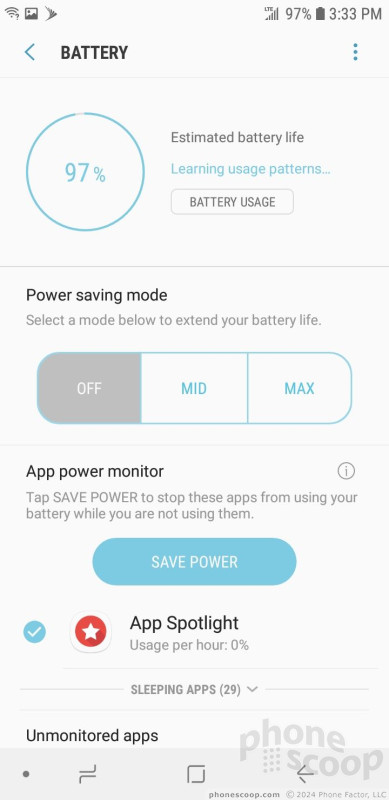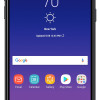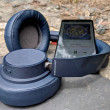Review: Samsung Galaxy A6 for Sprint
Oct 19, 2018, 3:57 PM by Eric M. Zeman

The Galaxy A6 from Samsung finds a good spot in the middle of Sprint's lineup. This affordable Android phone features a metal chassis, a pair of capable 16-megapixel cameras, and Samsung's Infinity Display. It looks and acts like a flagship at half the cost. Here is Phone Scoop's in-depth review.
Is It Your Type?
The Samsung Galaxy A6 delivers high-end looks at a mid-range price. It you want a phone that looks good, feels good, and includes many of today's latest features, the affordably-priced A6 is worth a gander.
Body
Just a couple of years ago, phones with aluminum chassis were all the rage. While many manufacturers now favor lots of glass to boost visual appeal, there's still something attractive about phones that are mostly metal.
The Galaxy A6 from Samsung is formed by an aluminum unibody. The metal spans the entire rear surface and wraps around to form the side edges. It reminds me of some HTC designs. It's a good look.
The A6 is all black. The glass is black, the metal chassis is matte black, and the antenna lines on the rear surface are black. One might say this phone is black metal. The front face is rather generic looking, but the rear is more distinctive.
The 5.6-inch screen helps keep the size in check. I wouldn't call it compact, but it's not a monstrous device by any stretch. The A6 is 2.79 inches wide. This relatively narrow width makes the phone easier to manage in a single hand. I appreciate the 7.7mm thickness. It feels solid and weighty, and yet I wouldn't call it overly heavy. I believe many people would find the A6 pleasant to use day in and day out. It drops into tight pockets easily.
I'm not worried about the A6's durability. The phone isn't ruggedized, but the metal chassis goes a long way to improving the phone's odds of surviving drops. The materials all feel good and come across as strong. All the parts are assembled tightly with no unsightly seams or gaps. The phone is not water resistant, so be careful around the pool.
The A6 has Samsung's "Infinity Display" but it's not quite the same as the Galaxy S series' glass. In this case, the phone's display is flat (rather than curved) and tall with a tall 2:1 ratio. Most of the face is screen, but you'll still see some bezel all around. The user-facing camera and flash stand out plainly.
On the left edge you'll find the volume controls and SIM tray. I like that Samsung separated the volume controls into two buttons. They have great travel and feedback. The SIM card tray accommodates both a nano SIM card and a microSD memory card. You'll need a tool to eject it.
Ports

The screen lock button is on the right edge. It has a good profile and pleasing action. A small hole cut into the side edge, fairly near to the top, is the speakerphone.
A microUSB port is on the bottom (no USB-C?!), as is a 3.5mm headphone jack. I'm happy about the jack, but bummed about the microUSB. There are no design elements on the top edge of the phone.
The rear panel is distinctive. It's mostly flat aluminum, but the antenna lines have a neat pattern to them. Moreover, the camera lens and fingerprint reader are bundled together in an unusual-looking module. In other words, it's not super boring. Samsung's logo is stamped into the metal and has a shiny finish that often catches the light.
Camera Module

No, you cannot access the battery.
The Samsung Galaxy A6 holds its own against devices in the same price range. It's a classy metal slate that anyone should be proud to carry around.
Screen
The display measures 5.6 inches across the diagonal with 1,480 by 720 pixels, making it HD+ at a ~2:1 ratio. Samsung calls this an Infinity Display, but it doesn't deliver the pop of the impressive panels on the S9 or Note9. The resolution is just barely good enough for me. There's a slight lack of focus along the borders of app icons and text.
It's a Samsung AMOLED panel, and that means the colors are pushed a bit. You'll see redder reds and bluer blues, for example. It's plenty bright. The screen cranks out some serious light, ensuring you can see the screen under most lighting conditions. Viewing angles are very good.
The screen has the usual set of controls for managing the blue light at night, color profiles, and so on.
Signal
AT&T and Sprint sell the Galaxy A6. We evaluated the Sprint model. The Sprint variant supports the carrier's unique 3G and LTE 4G network bands.
In general I was pleased with the phone's ability to connect to the network. All calls I made patched through without issue, and the phone didn't drop any while I tested it. Data speeds are mediocre, likely due in part to the Cat 6 LTE modem inside. I was never blown away with what I saw. The phone was able to stream standard-definition audio and video, but it still buffered a little bit. Browsing through social networks was choppy at times.
The A6 gets the job done, and should be fine for a mid-range phone.
Sound
The A6 is an average voice phone. Call volume fell short in noisier places like coffee shops. Quality was up and down. I noticed some minor distortion from time to time, and voices often sounded muffled. People I spoke to through the A6 said I sounded “quiet.”
That side speaker? It does all right. Speakerphone calls via that little side notch sound good enough for your home or office. It's not quite strong enough to properly handle a call in a moving car or outside on a windy day.
I'd rate the ringers and vibrate alert as sufficient.
Battery
Samsung gave the Galaxy A6 a 3,000mAh Lithium-polymer battery. It's sealed in the chassis. There's no wireless charging, nor is there any effective rapid charging. It takes close to two hours to charge the A6 up from 20%, which is annoyingly long.
Once it's charged, the phone pushes through a full day and just a little bit more. You can unplug at breakfast and still have enough charge left to get you to work the following morning. The A6 followed this pattern without fail. The only activity that really drains the battery in a hurry is GPS-based navigation.
The phone has Samsung's power management tools aboard, which means it will learn your usage patterns over time and attempt to maximize battery life. You can run the phone in “normal” mode, or with the power saver set to “mid” or “max.” Each dials back performance a bit to in order to conserve power.
Bluetooth, GPS, NFC, WiFi
I didn't run into any issues with the A6's secondary radios. The phone's Bluetooth did well. I was able to pair it with headphones and speakers, as well as my car and PCs. The pairing / connecting process typically took care of itself, and connections maintained. Call quality through my car was pretty rough.
The GPS radio worked well for navigation from A to B. It kept up with real-time, voice-guided directions, which is all I want from a phone these days. Google Maps is as powerful an app as ever.
The A6 supports Samsung Pay, thanks in part to the NFC radio. I was able to set up Samsung Pay and successfully make mobile payments with the A6. I was not, however, able to use the NFC radio for pairing with compatible Bluetooth accessories.
The WiFi did really well; no issues there.
Comments
No messages






























 Samsung Brings Galaxy A6 to the US for $360
Samsung Brings Galaxy A6 to the US for $360
 iPhone 15 Series Goes All-In on USB-C and Dynamic Island
iPhone 15 Series Goes All-In on USB-C and Dynamic Island
 Samsung S24 Series Adds More AI, Updates the Hardware
Samsung S24 Series Adds More AI, Updates the Hardware
 Samsung Puts its Best Camera Yet in the Galaxy S23 Ultra
Samsung Puts its Best Camera Yet in the Galaxy S23 Ultra
 Samsung Galaxy A6
Samsung Galaxy A6










